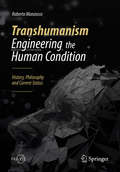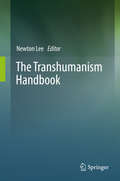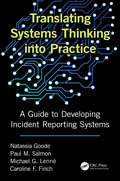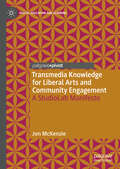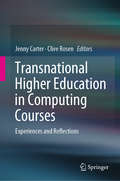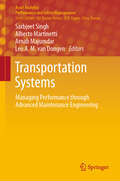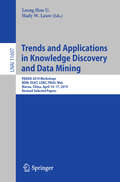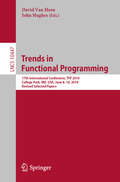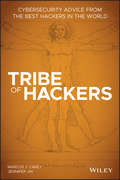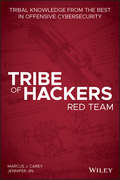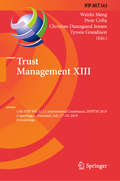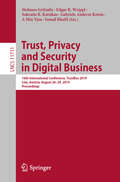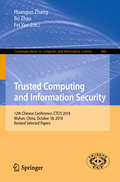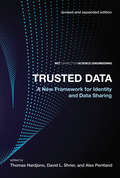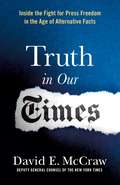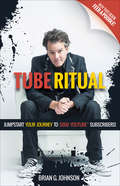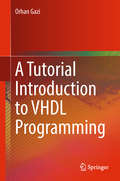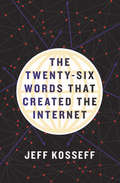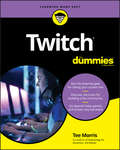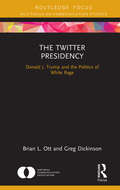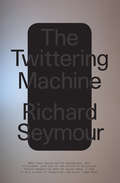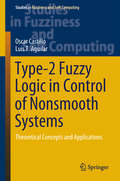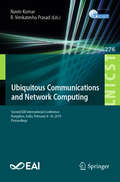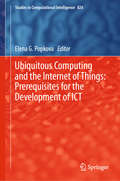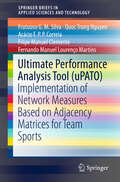- Table View
- List View
Transhumanism - Engineering the Human Condition: History, Philosophy and Current Status (Springer Praxis Books)
by Roberto ManzoccoThis book is designed to offer a comprehensive high-level introduction to transhumanism, an international political and cultural movement that aims to produce a “paradigm shift” in our ethical and political understanding of human evolution. Transhumanist thinkers want the human species to take the course of evolution into its own hands, using advanced technologies currently under development – such as robotics, artificial intelligence, biotechnology, cognitive neurosciences, and nanotechnology – to overcome our present physical and mental limitations, improve our intelligence beyond the current maximum achievable level, acquire skills that are currently the preserve of other species, abolish involuntary aging and death, and ultimately achieve a post-human level of existence. The book covers transhumanism from a historical, philosophical, and scientific viewpoint, tracing its cultural roots, discussing the main philosophical, epistemological, and ethical issues, and reviewing the state of the art in scientific research on the topics of most interest to transhumanists. The writing style is clear and accessible for the general reader, but the book will also appeal to graduate and undergraduate students.
The Transhumanism Handbook
by Newton LeeModern humanity with some 5,000 years of recorded history has been experiencing growing pains, with no end in sight. It is high time for humanity to grow up and to transcend itself by embracing transhumanism. Transhumanism offers the most inclusive ideology for all ethnicities and races, the religious and the atheists, conservatives and liberals, the young and the old regardless of socioeconomic status, gender identity, or any other individual qualities. This book expounds on contemporary views and practical advice from more than 70 transhumanists. Astronaut Neil Armstrong said on the Apollo 11 moon landing in 1969, “One small step for a man, one giant leap for mankind.” Transhumanism is the next logical step in the evolution of humankind, and it is the existential solution to the long-term survival of the human race.
Translating Systems Thinking into Practice: A Guide to Developing Incident Reporting Systems
by Natassia Goode Paul M. Salmon Michael Lenne Caroline FinchSystems thinking tells us that human error, violations and technology failures result from poorly designed and managed work systems. To help us understand and prevent injuries and incidents, incident reporting systems must be capable of collecting data on contributory factors from across the overall work system, in addition to factors relating to the immediate context of the event (e.g. front-line workers, environment, and equipment). This book describes how to design a practical, usable incident reporting system based on this approach. The book contains all the information needed to effectively design and implement a new incident reporting system underpinned by systems thinking. It also provides guidance on how to evaluate and improve existing incident reporting systems so they are practical for users, collect good quality data, and reflect the principles of systems thinking. Features Highlights the key principles of systems thinking for designing incident reporting systems Outlines a process for developing and testing incident reporting systems Describes how to evaluate incident reporting systems to ensure they are practical, usable, and collect good quality data Provides detailed guidance on how to analyze incident data, and translate the findings into appropriate incident prevention strategies
Transmedia Knowledge for Liberal Arts and Community Engagement: A StudioLab Manifesto (Digital Education and Learning)
by Jon McKenzieThis book sets forth a pedagogy for renewing the liberal arts by combining critical thinking, media activism, and design thinking. Using the StudioLab approach, the author seeks to democratize the social and technical practices of digital culture just as nineteenth century education sought to democratize literacy. This production of transmedia knowledge—from texts and videos to comics and installations—moves students between seminar, studio, lab, and field activities. The book also wrestles with the figure of Plato and the very medium of knowledge to re-envision higher education in contemporary societies, issuing a call for community engagement as a form of collective thought-action.
Transnational Higher Education in Computing Courses: Experiences and Reflections
by Jenny Carter Clive RosenThere has been exponential growth in transnational education (TNE) in the last few years as UK universities have looked to expand their markets. Recipient countries have sought short cuts to developing their higher education provision which has proved a lucrative income stream for some universities. But overseas collaborations are not without risk. Recipient countries can be concerned with external influence over curricula, quality being diluted and higher education being infected by neo-imperialism. These concerns are not without foundation. There are risks for providers too. Reputations can be damaged if academic standards are compromised. Conflicts of interest can occur between quality of provision and the pot of gold on offer. Staff can view overseas collaborations as distracting from their research and commitment to home students. Computing is a particularly popular subject for TNE, but critical thinking, analysis, independent learning, and creativity can be compromised. Preventing plagiarism is difficult. Constant changes in technology result in constant curricula revision which causes severe problems for overseas collaborations. This book focuses on TNE in the computing domain. However cross-cultural issues challenge TNE management and administration whatever the subject area. If the ever present tensions are not continuously monitored they can quickly threaten the sustainability of the collaboration. This book identifies many of the threats and some of the solutions. The readership for this book is truly global. Any international development officer in higher education considering an overseas collaboration will benefit from this book. Any academic becoming engaged in, or already involved with a TNE partnership, either as provider or recipient, will gain information and insight into the practice and issues. Researchers in TNE will discover more lines of enquiry. Students considering a course with an overseas provider or in coming to the UK to study will be better prepared thereby enabling a more fulfilling and rewarding experience. Anyone who has an interest in TNE, whether at the senior executive level, operational level, delivering programmes or as a recipient of TNE should read this book. The wealth of experience gathered here will provoke questions, prompt debate and offer solutions. It has been written by people who know the issues, bear the scars and are happy to share their knowledge. It will greatly benefit future transnational collaborations.
Transportation Systems: Managing Performance through Advanced Maintenance Engineering (Asset Analytics)
by Sarbjeet Singh Alberto Martinetti Arnab Majumdar Leo A. M. van DongenThis book explores the application of breakthrough technologies to improve transportation performance. Transportation systems represent the “blood vessels” of a society, in which people and goods travel. They also influence people’s lives and affect the liveability and sustainability of our cities. The book shows how emergent technologies are able to monitor the condition of the structure in real time in order to schedule the right moment for maintenance activities an so reduce the disturbance to users.This book is a valuable resource for those involved in research and development in this field. Part I discusses the context of transportation systems, highlighting the major issues and challenges, the importance of understating human factors that could affect the maintenance operations and the main goals in terms of safety standards. Part II focuses on process-oriented innovations in transportation systems; this section stresses the importance of including design parameters in the planning, offering a comparison between risk-based and condition-based maintenance and, lastly, showing applications of emergent technologies. Part III goes on to reflect on the technical-oriented innovations, discussing the importance of studying the physical phenomena that are behind transportation system failures and problems. It then introduces the general trend of collecting and analyzing big data using real-world cases to evaluate the positive and negative aspects of adopting extensive smart sensors for gathering information on the health of the assets. The last part (IV) explores cultural and behavioural changes, and new knowledge management methods, proposing novel forms of maintenance and vocational training, and introduces the need for radical new visions in transportation for managing unexpected events.The continuous evolution of maintenance fields suggests that this compendium of “state-of-the-art” applications will not be the only one; the authors are planning a collection of cutting-edge examples of transportation systems that can assist researchers and practitioners as well as students in the process of understanding the complex and multidisciplinary environment of maintenance engineering applied to the transport sector.
Trends and Applications in Knowledge Discovery and Data Mining: PAKDD 2019 Workshops, BDM, DLKT, LDRC, PAISI, WeL, Macau, China, April 14–17, 2019, Revised Selected Papers (Lecture Notes in Computer Science #11607)
by Leong Hou U. Hady W. LauwThis book constitutes the thoroughly refereed post-workshop proceedings of the workshops that were held in conjunction with the 23rd Pacific-Asia Conference on Knowledge Discovery and Data Mining, PAKDD 2019, in Macau, China, in April 2019.The 31 revised papers presented were carefully reviewed and selected from a total of 52 submissions. They stem from the following workshops: · PAISI 2019: 14th Pacific Asia Workshop on Intelligence and Security Informatics · WeL 2019: PAKDD 2019 Workshop on Weakly Supervised Learning: Progress and Future · LDRC 2019: PAKDD 2019 Workshop on Learning Data Representation for Clustering· BDM 2019: 8th Workshop on Biologically-inspired Techniques for Knowledge Discovery and Data Mining · DLKT 2019: 1st Pacific Asia Workshop on Deep Learning for Knowledge Transfer
Trends in Functional Programming: 17th International Conference, TFP 2016, College Park, MD, USA, June 8-10, 2016, Revised Selected Papers (Lecture Notes in Computer Science #10447)
by David Van Horn John HughesThis book constitutes the refereed proceedings of the 17th International Conference on Trends in Functional Programming, TFP 2016, held in College Park, USA, in June 2016.The 10 full papers presented in this volume were carefully reviewed and selected from 18 submissions. The papers were organized in topical sections named: implementation techniques; types and verification; and programming.
Tribe of Hackers: Cybersecurity Advice from the Best Hackers in the World (Tribe of Hackers)
by Marcus J. Carey Jennifer JinTribe of Hackers: Cybersecurity Advice from the Best Hackers in the World (9781119643371) was previously published as Tribe of Hackers: Cybersecurity Advice from the Best Hackers in the World (9781793464187). While this version features a new cover design and introduction, the remaining content is the same as the prior release and should not be considered a new or updated product. Looking for real-world advice from leading cybersecurity experts? You’ve found your tribe. Tribe of Hackers: Cybersecurity Advice from the Best Hackers in the World is your guide to joining the ranks of hundreds of thousands of cybersecurity professionals around the world. Whether you’re just joining the industry, climbing the corporate ladder, or considering consulting, Tribe of Hackers offers the practical know-how, industry perspectives, and technical insight you need to succeed in the rapidly growing information security market. This unique guide includes inspiring interviews from 70 security experts, including Lesley Carhart, Ming Chow, Bruce Potter, Robert M. Lee, and Jayson E. Street. Get the scoop on the biggest cybersecurity myths and misconceptions about security Learn what qualities and credentials you need to advance in the cybersecurity field Uncover which life hacks are worth your while Understand how social media and the Internet of Things has changed cybersecurity Discover what it takes to make the move from the corporate world to your own cybersecurity venture Find your favorite hackers online and continue the conversation Tribe of Hackers is a must-have resource for security professionals who are looking to advance their careers, gain a fresh perspective, and get serious about cybersecurity with thought-provoking insights from the world’s most noteworthy hackers and influential security specialists.
Tribe of Hackers Red Team: Tribal Knowledge from the Best in Offensive Cybersecurity
by Marcus J. Carey Jennifer JinWant Red Team offensive advice from the biggest cybersecurity names in the industry? Join our tribe.The Tribe of Hackers team is back with a new guide packed with insights from dozens of the world’s leading Red Team security specialists. With their deep knowledge of system vulnerabilities and innovative solutions for correcting security flaws, Red Team hackers are in high demand. Tribe of Hackers Red Team: Tribal Knowledge from the Best in Offensive Cybersecurity takes the valuable lessons and popular interview format from the original Tribe of Hackers and dives deeper into the world of Red Team security with expert perspectives on issues like penetration testing and ethical hacking. This unique guide includes inspiring interviews from influential security specialists, including David Kennedy, Rob Fuller, Jayson E. Street, and Georgia Weidman, who share their real-world learnings on everything from Red Team tools and tactics to careers and communication, presentation strategies, legal concerns, and more Learn what it takes to secure a Red Team job and to stand out from other candidates Discover how to hone your hacking skills while staying on the right side of the law Get tips for collaborating on documentation and reporting Explore ways to garner support from leadership on your security proposals Identify the most important control to prevent compromising your network Uncover the latest tools for Red Team offensive security Whether you’re new to Red Team security, an experienced practitioner, or ready to lead your own team, Tribe of Hackers Red Team has the real-world advice and practical guidance you need to advance your information security career and ready yourself for the Red Team offensive.
Trust Management XIII: 13th IFIP WG 11.11 International Conference, IFIPTM 2019, Copenhagen, Denmark, July 17-19, 2019, Proceedings (IFIP Advances in Information and Communication Technology #563)
by Weizhi Meng Piotr Cofta Christian Damsgaard Jensen Tyrone GrandisonThis book constitutes the refereed proceedings of the 13th IFIP WG 11.11 International Conference on Trust Management, IFIPTM 2019, held in Copenhagen, Denmark, in July 2019.The 7 revised full papers, 3 short papers, and 6 work-in-progress papers presented were carefully reviewed and selected from 32 submissions. The papers cover a broad range of topics related to trust, security and privacy and focus on trust in information technology and identity management, socio-technical and sociological trust, and emerging technology for trust.
Trust, Privacy and Security in Digital Business: 16th International Conference, TrustBus 2019, Linz, Austria, August 26–29, 2019, Proceedings (Lecture Notes in Computer Science #11711)
by Stefanos Gritzalis Edgar R. Weippl Sokratis K. Katsikas Gabriele Anderst-Kotsis A Min Tjoa Ismail KhalilThis book constitutes the refereed proceedings of the 16th International Conference on Trust, Privacy and Security in Digital Business, TrustBus 2019, held in Linz, Austria, in August 2019 in conjunction with DEXA 2019. The 11 full papers presented were carefully reviewed and selected from 24 submissions. The papers are organized in the following topical sections: privacy; and audit, compliance and threat intelligence.The chapter "A data utility-driven benchmark for de-identification methods" is open access under a CC BY 4.0 license at link.springer.com.
Trusted Computing and Information Security: 12th Chinese Conference, CTCIS 2018, Wuhan, China, October 18, 2018, Revised Selected Papers (Communications in Computer and Information Science #960)
by Huanguo Zhang Bo Zhao Fei YanThis book constitutes the refereed proceedings of the Chinese Conference on Trusted Computing and Information Security, CTCIS 2018, held in Wuhan, China, in October 2018.The 24 revised full papers presented were carefully reviewed and selected from 73 submissions. The papers are centered around cryptography, systems security, trusted computing, information security, and network security.
Trusted Data, revised and expanded edition: A New Framework for Identity and Data Sharing
by Thomas Hardjono David L. Shrier Alex PentlandHow to create an Internet of Trusted Data in which insights from data can be extracted without collecting, holding, or revealing the underlying data.Trusted Data describes a data architecture that places humans and their societal values at the center of the discussion. By involving people from all parts of the ecosystem of information, this new approach allows us to realize the benefits of data-driven algorithmic decision making while minimizing the risks and unintended consequences. It proposes a software architecture and legal framework for an Internet of Trusted Data that provides safe, secure access for everyone and protects against bias, unfairness, and other unintended effects. This approach addresses issues of data privacy, security, ownership, and trust by allowing insights to be extracted from data held by different people, companies, or governments without collecting, holding, or revealing the underlying data. The software architecture, called Open Algorithms, or OPAL, sends algorithms to databases rather than copying or sharing data. The data is protected by existing firewalls; only encrypted results are shared. Data never leaves its repository. A higher security architecture, ENIGMA, built on OPAL, is fully encrypted.ContributorsMichiel Bakker, Yves-Alexandre de Montjoye, Daniel Greenwood, Thomas Hardjoni, Jake Kendall, Cameron Kerry, Bruno Lepri, Alexander Lipton, Takeo Nishikata, Alejandro Noriega-Campero, Nuria Oliver, Alex Pentland, David L. Shrier, Jacopo Staiano, Guy ZyskindAn MIT Connection Science and Engineering Book
Truth in Our Times: Inside the Fight for Press Freedom in the Age of Alternative Facts
by David E. McCrawDavid E. McCraw recounts his experiences as the top newsroom lawyer for the New York Times during the most turbulent era for journalism in generations.In October 2016, when Donald Trump's lawyer demanded that The New York Times retract an article focused on two women that accused Trump of touching them inappropriately, David McCraw's scathing letter of refusal went viral and he became a hero of press freedom everywhere. But as you'll see in Truth in Our Times, for the top newsroom lawyer at the paper of record, it was just another day at the office.McCraw has worked at the Times since 2002, leading the paper's fight for freedom of information, defending it against libel suits, and providing legal counsel to the reporters breaking the biggest stories of the year. In short: if you've read a controversial story in the paper since the Bush administration, it went across his desk first. From Chelsea Manning's leaks to Trump's tax returns, McCraw is at the center of the paper's decisions about what news is fit to print.In Truth in Our Times, McCraw recounts the hard legal decisions behind the most impactful stories of the last decade with candor and style. The book is simultaneously a rare peek behind the curtain of the celebrated organization, a love letter to freedom of the press, and a decisive rebuttal of Trump's fake news slur through a series of hard cases. It is an absolute must-have for any dedicated reader of The New York Times.
Tube Ritual: Jumpstart Your Journey to 5000 YouTube Subscribers
by Brian G. JohnsonEverybody begins their YouTube journey from zero.You have to start with no videos, views, or subscribers. Furthermore, more than 400 minutes of content is uploaded to YouTube each minute. To say that it&’s challenging to grow a channel is an understatement! In fact, less than 3% of YouTube channels ever gain more than 10,000 subscribers. Yet, in a one-year period, Brian G Johnson gained 10,623 subscribers and drove over half a million video views. Truly beginning from zero. Brian had no previous YouTube success to draw from and had to learn the myriad of camera settings, editing options, and technical details that often become a roadblock. Furthermore, he did it in a small and competitive niche, the YouTube video marketing niche.How, you ask?By researching, testing, and tweaking various video growth methods over a one-year period in order to identify why the YouTube algorithm promotes one video over another. Ultimately, this led to the creation of a video ritual based on his findings—a series of actions according to a prescribed order. More than a mere guide, Tube Ritual is a one-year case study with the goal being to drive more views and convert more viewers into subscribers. For those already creating videos or who want to in the future, Tube Ritual contains detailed, step-by-step information that plain works. From Branding to thumbnails, video structure, YouTube SEO, video calls to action, playlist strategies, channel strategies and more, Tube Ritual leaves no stone unturned.
A Tutorial Introduction to VHDL Programming
by Orhan GaziThis book helps readers create good VHDL descriptions and simulate VHDL designs. It teaches VHDL using selected sample problems, which are solved step by step and with precise explanations, so that readers get a clear idea of what a good VHDL code should look like.The book is divided into eight chapters, covering aspects ranging from the very basics of VHDL syntax and the module concept, to VHDL logic circuit implementations. In the first chapter, the entity and architecture parts of a VHDL program are explained in detail. The second chapter explains the implementations of combinational logic circuits in VHDL language, while the following chapters offer information on the simulation of VHDL programs and demonstrate how to define data types other than the standard ones available in VHDL libraries. In turn, the fifth chapter explains the implementation of clocked sequential logic circuits, and the sixth shows the implementation of registers and counter packages. The book’s last two chapters detail how components, functions and procedures, as well as floating-point numbers, are implemented in VHDL. The book offers extensive exercises at the end of each chapter, inviting readers to learn VHDL by doing it and writing good code.
The Twenty-Six Words That Created the Internet
by Jeff Kosseff"No provider or user of an interactive computer service shall be treated as the publisher or speaker of any information provided by another information content provider."Did you know that these twenty-six words are responsible for much of America's multibillion-dollar online industry? What we can and cannot write, say, and do online is based on just one law—a law that protects online services from lawsuits based on user content. Jeff Kosseff exposes the workings of Section 230 of the Communications Decency Act, which has lived mostly in the shadows since its enshrinement in 1996. Because many segments of American society now exist largely online, Kosseff argues that we need to understand and pay attention to what Section 230 really means and how it affects what we like, share, and comment upon every day.The Twenty-Six Words That Created the Internet tells the story of the institutions that flourished as a result of this powerful statute. It introduces us to those who created the law, those who advocated for it, and those involved in some of the most prominent cases decided under the law. Kosseff assesses the law that has facilitated freedom of online speech, trolling, and much more. His keen eye for the law, combined with his background as an award-winning journalist, demystifies a statute that affects all our lives –for good and for ill. While Section 230 may be imperfect and in need of refinement, Kosseff maintains that it is necessary to foster free speech and innovation. For filings from many of the cases discussed in the book and updates about Section 230, visit jeffkosseff.com
Twitch For Dummies
by Tee MorrisThe first full resource to offer advice on tapping into Twitch Twitch got its start as a live-streaming platform mostly populated by gamers and their fans. It's quickly grown to host streaming events of all kinds—concerts, conferences, production events like podcast recording sessions, and even pro sports. Twitch For Dummies helps initiate those new to streaming with advice on how to launch and build a Twitch channel. Podcasting For Dummies author Tee Morris guides readers through the basics of starting a channel, streaming games or live events, growing and interacting with an audience, and how to overcome common tech glitches. • Build a streaming studio • Create your Twitch profile • Find successful streaming strategies • Interact with your audience This guide offers friendly, reliable advice for broadcasters, marketers, and video fans on how to tap into the most popular online live-streaming service.
The Twitter Presidency: Donald J. Trump and the Politics of White Rage (NCA Focus on Communication Studies)
by Brian L. Ott Greg DickinsonThe Twitter Presidency explores the rhetorical style of President Donald J. Trump, attending to both his general manner of speaking as well as to his preferred modality. Trump’s manner, the authors argue, reflects an aesthetics of white rage, and it is rooted in authoritarianism, narcissism, and demagoguery. His preferred modality of speaking, namely through Twitter, effectively channels and transmits the affective dimensions of white rage by taking advantage of the platform’s defining characteristics, which include simplicity, impulsivity, and incivility. There is, then, a structural homology between Trump’s general communication practices and the specific platform (Twitter) he uses to communicate with his base. This commonality between communication practices and communication platform (manner and modality) struck a powerful emotive chord with his followers, who feel aggrieved at the decentering of white masculinity. In addition to charting the defining characteristics of Trump’s discourse, The Twitter Presidency exposes how Trump’s rhetorical style threatens democratic norms, principles, and institutions.
The Twittering Machine
by Richard SeymourA brilliant probe into the political and psychological effects of our changing relationship with social mediaFormer social media executives tell us that the system is an addiction-machine. We are users, waiting for our next hit as we like, comment and share. We write to the machine as individuals, but it responds by aggregating our fantasies, desires and frailties into data, and returning them to us as a commodity experience. The Twittering Machine is an unflinching view into the calamities of digital life: the circus of online trolling, flourishing alt-right subcultures, pervasive corporate surveillance, and the virtual data mines of Facebook and Google where we spend considerable portions of our free time. In this polemical tour de force, Richard Seymour shows how the digital world is changing the ways we speak, write, and think. Through journalism, psychoanalytic reflection and insights from users, developers, security experts and others, Seymour probes the human side of the machine, asking what we&’re getting out of it, and what we&’re getting into. Social media held out the promise that we could make our own history–to what extent did we choose the nightmare that it has become?
Type-2 Fuzzy Logic in Control of Nonsmooth Systems: Theoretical Concepts And Applications (Studies in Fuzziness and Soft Computing #373)
by Oscar Castillo Luis T. AguilarThis book presents the synthesis and analysis of fuzzy controllers and its application to a class of mechanical systems. It mainly focuses on the use of type-2 fuzzy controllers to account for disturbances known as hard or nonsmooth nonlinearities. The book, which summarizes the authors’ research on type-2 fuzzy logic and control of mechanical systems, presents models, simulation and experiments towards the control of servomotors with dead-zone and Coulomb friction, and the control of both wheeled mobile robots and a biped robot. Closed-loop systems are analyzed in the framework of smooth and nonsmooth Lyapunov functions.
Ubiquitous Communications and Network Computing: Second EAI International Conference, Bangalore, India, February 8–10, 2019, Proceedings (Lecture Notes of the Institute for Computer Sciences, Social Informatics and Telecommunications Engineering #276)
by Navin Kumar R. Venkatesha PrasadThis book constitutes the refereed proceedings of the Second International Conference on Ubiquitous Communications and Network Computing, UBICNET 2019, held in Bangalore, India, in February 2019. The 19 full papers were selected from 52 submissions and are basically arranged in different sessions on security and energy efficient computing, software defined networks, cloud computing and internet of things applications, and the advanced communication systems and networks.
Ubiquitous Computing and the Internet of Things: Prerequisites for the Development of ICT (Studies in Computational Intelligence #826)
by Elena G. PopkovaThis book gathers the outcomes of several scientific events that were organized and conducted by the Institute of Scientific Communications (Volgograd, Russia) and the leading universities of the Volgograd region. The contributing authors include more than 700 scholars from various cities and regions of Russia. 124 works were selected out of 3,000 papers on the preconditions of formation, transformation, and legal provision of social institutes, topics that are in high demand in connection with a core aspect of digital modernization – the Internet of Things. The book is intended for a broad target audience, including scholars of various generations and various disciplines. These include young researchers (undergraduates and postgraduates) and recognized scholars (professors and lecturers) who study the socio-economic and legal consequences of the emergence and dissemination of digital technologies, including the Internet of Things. In addition, the book will benefit all those who are interested in the development of the information society, information and telecommunication, and digital technologies. The content is divided into three logical parts, the first of which is devoted to the essence of the process of institutionalization and legal regulation of the information society. In the second part, the digital economy is analyzed in view of the spheres of the national economy. In the third, the authors study the peculiarities of state and corporate regulation, infrastructural provision and support for the security of entrepreneurship, which are currently developing on the basis of the Internet of Things.
Ultimate Performance Analysis Tool: Implementation Of Network Measures Based On Adjacency Matrices For Team Sports (SpringerBriefs in Applied Sciences and Technology)
by Fernando Manuel Martins Acácio F.P.P. Correia Frutuoso G. Silva Filipe Manuel Clemente Quoc Trong NguyenThis book introduces the ultimate performance analysis tool (uPATO) as a new software to compute social network metrics in the scope of team sports analysis. The reader will identify the algorithms to test the general properties of the team, the co-dependencies and the centrality levels of players, i.e. to evaluate the individual, sub-group, and team performance analysis. As uPATO tool implements the metrics for all options, namely for unweighted graphs, weighted graphs, unweighted digraphs and weighted digraphs, it is also useful for network analysis into other areas beyond team sports. The book assists the reader to compute the metrics and to use it in different scenarios.
